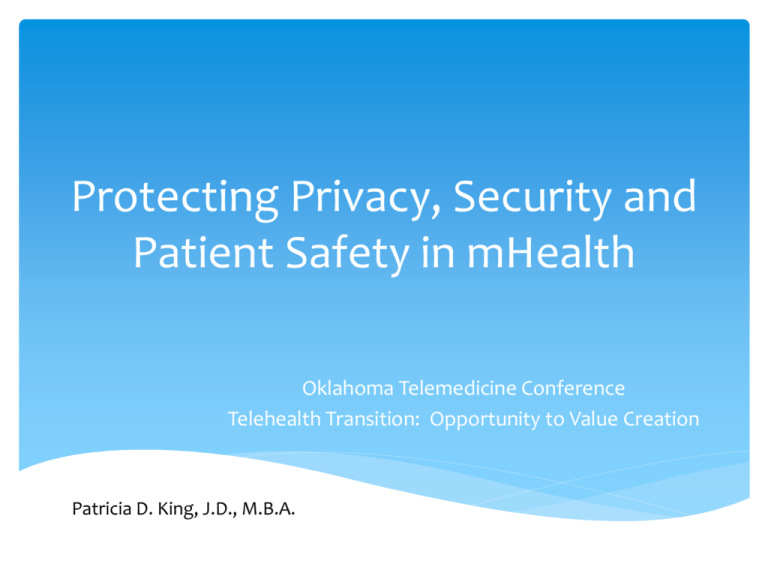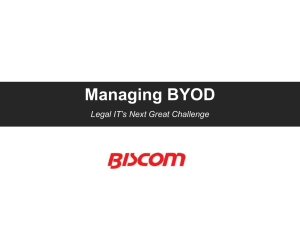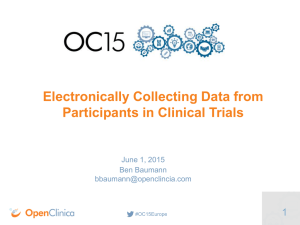Protecting Privacy, Security and Patient Safety in mHealth
advertisement

Protecting Privacy, Security and Patient Safety in mHealth Oklahoma Telemedicine Conference Telehealth Transition: Opportunity to Value Creation Patricia D. King, J.D., M.B.A. HIPAA Privacy and Breach Notification Many reported breaches of unsecured PHI involve mobile devices Examples: Massachusetts Eye & Ear Infirmary settled case for $1.5 million, agreed to adopt safeguards for mobile devices OCR has developed compliance resources specifically for mobile devices* Portability and ease of use of mobile devices create unique risks http://www.healthit.gov/providers-professionals/your-mobiledevice-and-health-information-privacy-and-security HIPAA Security HIPAA Security Rule requires covered entities to periodically review their security procedures when technology changes and introduces new risks Access to EPHI on mobile devices is a significant operational change requiring providers to revisit their security policies and procedures BYOD introduces additional vulnerabilities ENCRYPTION, ENCRYPTION, ENCRYPTION! NIST Guidelines for Mitigating Risk of Mobile Devices* Risk: theft or loss Mitigation: Encryption Permitting access to EPHI but not storage Device-based authentication Network-based authentication Risk: inherent vulnerabilities due to lack of root of trust features Mitigation: Centralized mobile device management technology If BYOD is permitted, isolation of organization’s data and applications Guidelines for Managing the Security of Mobile Devices in the Enterprise, NIST Special Publication 800-124, Rev. 1 NIST guidelines (cont’d) Risk: “man in the middle” attacks on unsecure networks Mitigation: Use of virtual private network (VPN) Risk: introduction of malware through apps Mitigation: Prohibiting installation of third-party apps unless “white-listed” Prohibiting browser access or forcing through secure gateway Special Considerations for BYOD* Advantages: user satisfaction, potential savings on device purchases If BYOD is permitted, the user-owned device will have 2 information owners: the user for personal data, and the organization for EPHI and business processes. If the organization’s data and apps are confined to a sandbox/secure container, then a remote wipe can be performed if the device is vulnerable without disrupting the owner’s data. Guidelines on Hardware-Rooted Security in Mobile Devices, NIST Special Publication 800-164 (draft) Other Security Considerations FDA guidance on cybersecurity for medical devices and networked hospital systems* 2014 Work Plan of the HHS Office of Inspector General states that OIG intends to review security controls implemented by hospitals for portable devices containing PHI and networked medical devices FDA Safety Communication: Cybersecurity for Medical Devices and Hospital Networks, June 13, 2013 Patient Safety 2011 Institute of Medicine report focused on how health information technology can itself contribute to medical errors, through poor usability of electronic health records, alert fatigue, and other factors* HHS Office of the National Coordinator for HIT has developed numerous resources to help providers assess safety features of health information technology** *Institute of Medicine, Health IT and Patient Safety: Building Safer Systems for Better Care, 2011 **http://www.healthit.gov/sites/default/files/safety_plan_master.pdf FDASIA 2012 Food and Drug Administration Safety and Innovation Act required the FDA, ONC and FCC to issue a report on development of an “appropriate risk-based regulatory framework pertaining to health information technology, that promotes innovation, protects patient safety, and avoids regulatory duplication” FDASIA Health IT Report* recommends that assessment of risk and needed controls should focus on HIT functionality, not on the platform (mobile, cloud, etc.) on which the functionality resides FDASIA Health IT Report: Proposed Strategy and Recommendations for a Risk-Based Framework, April 2014 FDA Guidance on Mobile Medical Apps FDA guidance states that the FDA intends to regulate only those mobile apps that meet the definition of a medical device under the Food, Drug and Cosmetic Act, or that is intended to be used as an accessory to a medical device or to transform a mobile platform into a medical device Since apps that are not mobile medical apps will not have FDA review, providers considering us of the app should conduct their own review of the app’s effectiveness Role of the FCC The Federal Communications Commission has expanded access to radio frequency spectrum for wireless medical communications Wireless Medical Telemetry Service MedRadio Service Medical Micro-Power Networks Medical Body Area Networks Focus of FCC regulation is avoiding interference among users of wireless spectrum







